Uzbekistan Part I - The Legendary Land of Samarkand
 |
| The Registan |
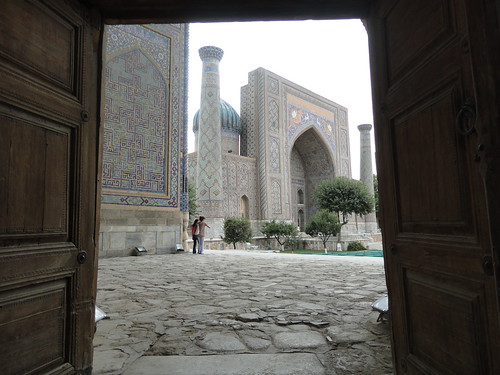 There was nothing fable-like, though, about arriving into Tashkent Airport in the wee hours of the night. No romantic references to its historical past. Passengers applauded as the plane touched down. Sweet gesture; I know it was Russian Airlines after all, but were they just pleasantly surprised to have landed?
There was nothing fable-like, though, about arriving into Tashkent Airport in the wee hours of the night. No romantic references to its historical past. Passengers applauded as the plane touched down. Sweet gesture; I know it was Russian Airlines after all, but were they just pleasantly surprised to have landed?Visa and passport procedures cleared, we dutifully filled in all our customs declarations papers x four in duplicate by hand, no such thing as carbon paper. Not wanting to get into strife for being evasive we obediently declared all medicines and electronic equipment as per the questions. The customs lady took one look at the forms and scribbled out all our declarations in the ‘yes’ column and proceeded to cross the ‘no’ boxes. Ooh, I like this place already. I had pre-arranged a letter of invitation into the country, necessary for a visa, via email through a local travel agent, Airat, who had a driver waiting for us at the airport exit, past all the people calling out if we wanted a taxi.
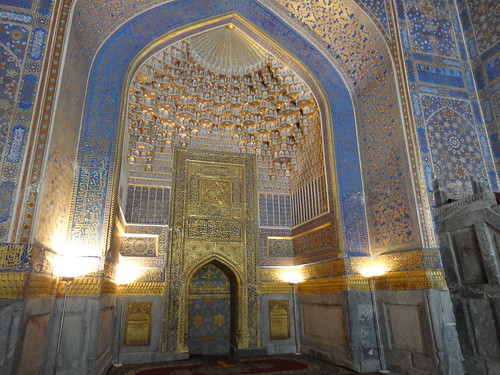 Waking up the next morning my most vivid memory is running to the window to throw back the curtains to see the land of the Silk Road legends. I was so excited to be in such a faraway exotic locale and I was keen to get cracking and see it. Immediately, I copped an eyeful of glaring sunlight blinding me for a moment until I could make out the city rooftops of Tashkent from the heights of the ‘Hotel Uzbekistan’ – a renovated 4-star (cough, cough) Russian dinosaur come to life as a free market hotel with smiling, efficient staff only too willing to assist. I was surprised to see how green the city looked from way up yonder on the 16th floor.
Marat, the same driver that collected us from the airport, and who is also Airat’s brother, took us to meet Airat the next day. On the way we stopped off at a nearby black market moneychanger where the equivalent of US$200 was returned to us in a black plastic shopping bag the size of a small saddlebag filled with Uzbek som. The highest denomination is 1000 som (about AUD40 cents’ worth) and the black market rate is far more favourable than the official exchange rate. They love hard currency here and this ain’t no Mastercard wonderland. Can you imagine how many wheelbarrowsful you’d need to pay for a car or house!
Waking up the next morning my most vivid memory is running to the window to throw back the curtains to see the land of the Silk Road legends. I was so excited to be in such a faraway exotic locale and I was keen to get cracking and see it. Immediately, I copped an eyeful of glaring sunlight blinding me for a moment until I could make out the city rooftops of Tashkent from the heights of the ‘Hotel Uzbekistan’ – a renovated 4-star (cough, cough) Russian dinosaur come to life as a free market hotel with smiling, efficient staff only too willing to assist. I was surprised to see how green the city looked from way up yonder on the 16th floor.
Marat, the same driver that collected us from the airport, and who is also Airat’s brother, took us to meet Airat the next day. On the way we stopped off at a nearby black market moneychanger where the equivalent of US$200 was returned to us in a black plastic shopping bag the size of a small saddlebag filled with Uzbek som. The highest denomination is 1000 som (about AUD40 cents’ worth) and the black market rate is far more favourable than the official exchange rate. They love hard currency here and this ain’t no Mastercard wonderland. Can you imagine how many wheelbarrowsful you’d need to pay for a car or house!
 |
| Uzbek Som currency - equivalent to US$150 |
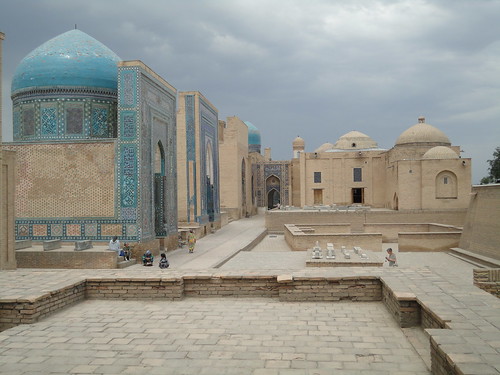 |
| Shah-I-Zinda, Avenue of Mausoleums |
Samarkand is truly a treasure trove of architectural wonders and nothing quite prepared us for its monumental attraction, the majestic 14th century Registan. To gaze over this vast walled-in complex of blue-domed mosques, madrassas (Islamic schools), courtyards, soaring minarets and geometrically-patterned tiled walls and portals in cool blues left us in awe. The two-storey high madrassas here once housed thousands of students and teachers in tight cell-like tiled windowless rooms. Students slept inside their classrooms, some in small loft-like areas near the ceilings reached by wooden ladder. Imagine sleeping and learning all within the space of a small few square metres! Teachers also had their living quarters on site. It was here that Ulugbek, a 15th century ruler and renowned medieval mathematician- astronomer, apart from ruling, warring and inventing would also spend one day a week teaching mathematics to students in the madrassas, so we were told. He was keen on education and had a special talent for maths, science and astronomy to the extent that his calculations are still considered fairly accurate today. Can you imagine our country’s leaders being remotely interested in doing that whilst in office? Souvenir sellers now fill the ancient madrassas and courtyards. Akhbar, a retired journalist, acted as our guide, leading us through this enormous site and its maze of spaces, as well as to Samarkand’s other historical places. His specialty was cultural reporting in the local newspaper and he certainly had a vast knowledge of the country, its rulers and history, as well as sharing with us what life is like in modern times Uzbekistan, pointing to his blogsite on his business card. He was also curious to ask about the way of life in Australia.
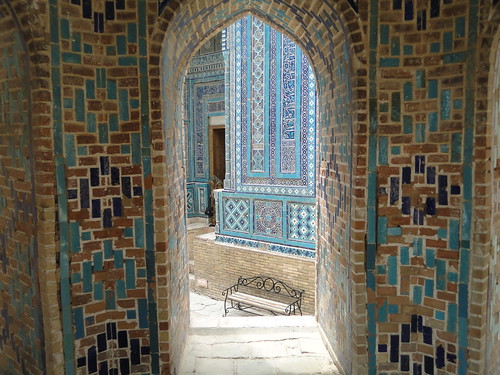 We were taken through a slice of history from ancient mosques and mausoleums, some in a state of mud brick decay (which I much preferred) and others recently gaudily restored so that they appeared almost brand new, through to the remains of Ulugbek’s astronomical observatory. Genghis Khan, revered leader in his Mongolian homeland and dreaded by others, arrived early in the 13th century, decimating and burning Samarkand and much of Uzbekistan’s history. What we saw was rebuilt after his sacking of the country. The beautiful filigree-tiled Shah-I-Zinda Avenue of Mausoleums, which sounds rather morbid but wasn’t, was the most photogenic and atmospheric, particularly as dark clouds gathered overhead lending it a rather dramatic backdrop. Most of the tourists here were local women in headscarves, multicolured dresses worn over colourful pants and flashes of gold teeth when they smiled. The traditional monobrow-look is fashionable for some married women, the space between eyebrows filled with black pencil. Whilst gawping at the ruined splendour of the Bibi Khonym Mosque, another of Samarkand’s remarkable sights, a young man with golden teeth accompanied by his shy new wife approached Max to say hello and asked questions of us in his faltering English. Max’s initial reaction was one of caution, strangers don’t usually approach unless they’re after something, right? Well, he’d learnt English 15 years ago (Russian and Uzbek are the national languages spoken) and was keen to put it into practise. We found out that speaking with foreigners also entitles them to boasting rights amongst family and friends.
We were taken through a slice of history from ancient mosques and mausoleums, some in a state of mud brick decay (which I much preferred) and others recently gaudily restored so that they appeared almost brand new, through to the remains of Ulugbek’s astronomical observatory. Genghis Khan, revered leader in his Mongolian homeland and dreaded by others, arrived early in the 13th century, decimating and burning Samarkand and much of Uzbekistan’s history. What we saw was rebuilt after his sacking of the country. The beautiful filigree-tiled Shah-I-Zinda Avenue of Mausoleums, which sounds rather morbid but wasn’t, was the most photogenic and atmospheric, particularly as dark clouds gathered overhead lending it a rather dramatic backdrop. Most of the tourists here were local women in headscarves, multicolured dresses worn over colourful pants and flashes of gold teeth when they smiled. The traditional monobrow-look is fashionable for some married women, the space between eyebrows filled with black pencil. Whilst gawping at the ruined splendour of the Bibi Khonym Mosque, another of Samarkand’s remarkable sights, a young man with golden teeth accompanied by his shy new wife approached Max to say hello and asked questions of us in his faltering English. Max’s initial reaction was one of caution, strangers don’t usually approach unless they’re after something, right? Well, he’d learnt English 15 years ago (Russian and Uzbek are the national languages spoken) and was keen to put it into practise. We found out that speaking with foreigners also entitles them to boasting rights amongst family and friends.
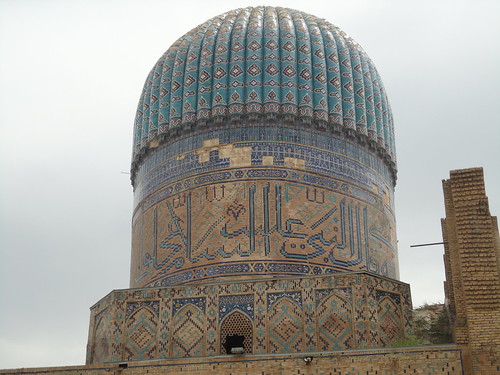 |
| Ribbed dome of remains of Bibi Khonym Mosque |
Walking around the Registan’s perimeter at dusk on a different day, Max and I came upon a bazaar that was still a hive of activity just before closing time. There were nougats, homemade sweets, fruits, vegetables, nuts, dried fish and rounds of local flat breads. Foods were being sold from trestle tables, out of prams, shopping trolleys, buckets, sacks, baskets, boxes and tablecloths laid out on the ground. Most of the sellers were women, some of whom tried coaxing us to sample their sweets.
A park opposite the Registan was respite for us as the hot day time temperature dropped. Locals were out and about here relaxing and escaping the heat of their homes. Whilst sitting resting on a bench, a young child came forward and handed over a paper bag with sweet pastries to us. Her mother had sent her over. Nargiza was the mother’s name and she, like her mother and grandmother, is a doctor. Amongst other things we learnt that her little daughter Farina loves Lady Gaga’s music (wouldn’t you believe it!), that doctors are poorly paid, she shares a house with 17 other relatives of three generations including her parents-in-law, brother-in-law & his family and her own children and husband, and that she was keen to distinguish herself as Tartar.
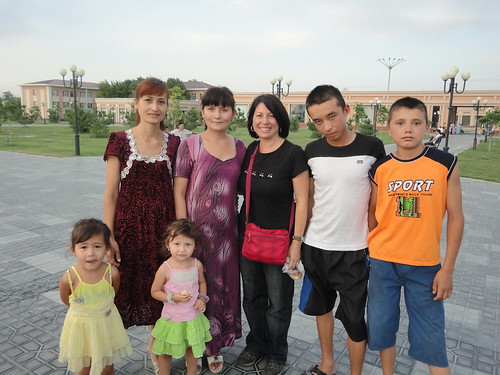 |
| Friendly Uzbek family pose with me |
Nargiza was accompanied by a few of her relatives, one of which was a young teenage boy keen to ask questions in his limited English. “How many people in you house?” he asks me. “Two”, I reply, “myself and my husband”. Boy’s response – “ Ahhh, you lucky. You have good life”. Youbetcha! Blessed is what I’d call it. After posing for family photos and promising to email after exchanging addresses, we waved goodbye.
However, this wasn’t the end of an extraordinary day. Further along, I hear bellydance-style music and it draws me. Dragging Max in the direction of the band, we came across an outdoor venue where I tried to sneak peek with my eyes as well as the camera. A woman came forth and beckoned us in to take photos. How could we resist witnessing a wedding spectacle with 400 to 500 guests seated on gold-clothed chairs at gold-draped tables listening to a traditional Uzbek band on stage with a young bridal couple sitting almost lost behind masses of tulle and flowers? There was a film crew with blazing lights and a camera posted on a long boom that hovered over guests’ heads, a multitude of waiters in white shirts and skinny black ties (you know, the 60’s retro look), an enormous flat screen and a large splashing fountain.
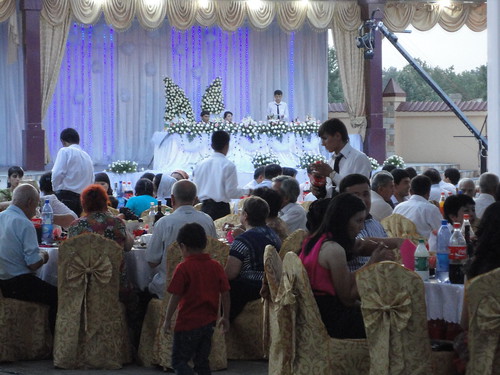 |
| Evening highlight |
The woman was the mother of one of the bridal pair and she willingly posed for photos with me. Without speaking a word of English, she wanted us to sit down and partake of the feast. Mortified we shook our heads and pointed to our jeans and T-shirts. This was no excuse and in seconds, with great embarrassment, we were whisked over and introduced to a table of relatives (more gold teeth smiling), plied with vodka and bowls of steaming soup placed in front of us. The table was loaded with food – by the looks of it, all the courses were on display at once from the caviar nibbles, to platters of cold meats, salads, savoury pastries, cooked meat dishes, fruit bowls, chocolates, nuts and cream-smothered tortes wilting in the heat. There was one lesson the Soviet occupation of Uzbekistan had taught them - how to drink vodka. As soon as our glasses emptied they were filled up again. Bellydancers in long shimmery dresses danced around the tables collecting money from guests, which went to the bridal couple. An English-speaking nephew who had worked in the UK told us “eat as much as you like, stay as long as you like, you’re our guests”.
Just as the party was really rocking we had to say our goodbyes – we had arranged for Marat to pick us up at a certain time and place. The mother insisted that we stay longer and join in the dancing which was about to begin. Oh, how I would have loved to, walking boots and all, but alas our carriage awaited us. Samarkand has been legendary in many ways, from its history and its monuments to its incredible hospitality from strangers that have all left a big impression on us. How lucky we are to have had such an awesome experience.
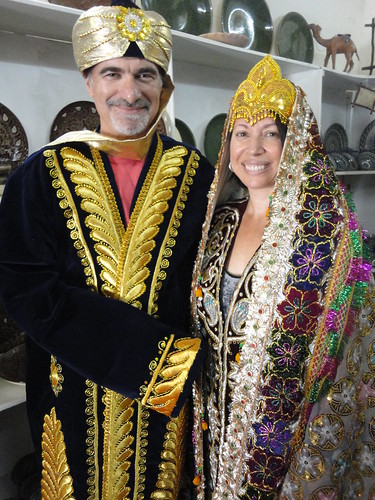 |
| Looking rather dapper attired in traditional wedding clothes |


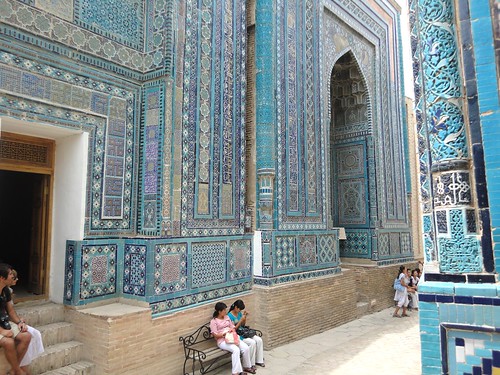
 Hi, I'm Eva - world traveller, cultural explorer and experience seeker. Together with my husband Max, we've been globetrotting for over 20 years.
Hi, I'm Eva - world traveller, cultural explorer and experience seeker. Together with my husband Max, we've been globetrotting for over 20 years.







0 comments: